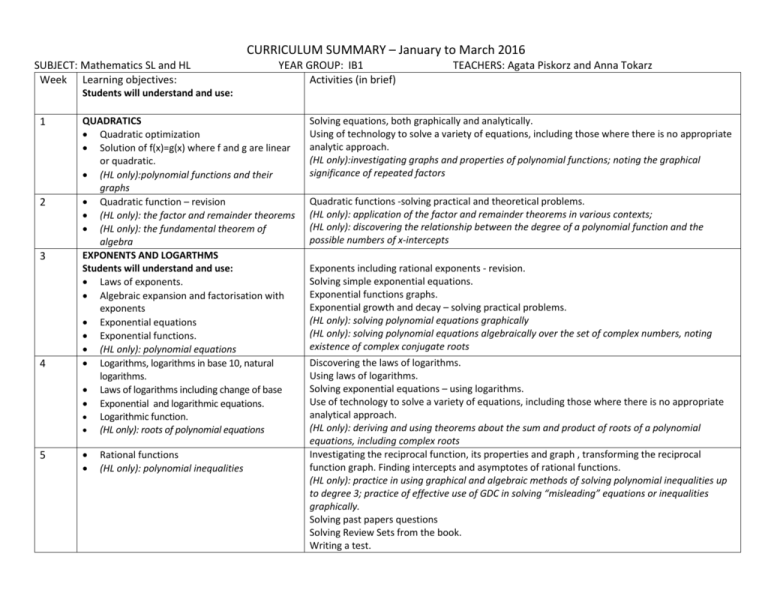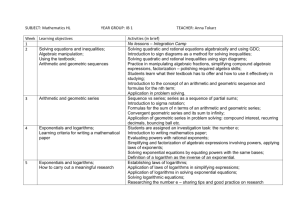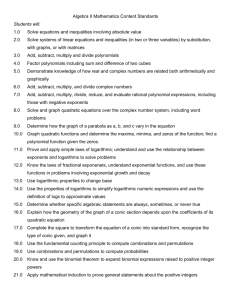CURRICULUM SUMMARY * September to October 2008
advertisement

CURRICULUM SUMMARY – January to March 2016 SUBJECT: Mathematics SL and HL Week Learning objectives: YEAR GROUP: IB1 Activities (in brief) TEACHERS: Agata Piskorz and Anna Tokarz Students will understand and use: 1 2 3 4 5 QUADRATICS Quadratic optimization Solution of f(x)=g(x) where f and g are linear or quadratic. (HL only):polynomial functions and their graphs Quadratic function – revision (HL only): the factor and remainder theorems (HL only): the fundamental theorem of algebra EXPONENTS AND LOGARTHMS Students will understand and use: Laws of exponents. Algebraic expansion and factorisation with exponents Exponential equations Exponential functions. (HL only): polynomial equations Logarithms, logarithms in base 10, natural logarithms. Laws of logarithms including change of base Exponential and logarithmic equations. Logarithmic function. (HL only): roots of polynomial equations Rational functions (HL only): polynomial inequalities Solving equations, both graphically and analytically. Using of technology to solve a variety of equations, including those where there is no appropriate analytic approach. (HL only):investigating graphs and properties of polynomial functions; noting the graphical significance of repeated factors Quadratic functions -solving practical and theoretical problems. (HL only): application of the factor and remainder theorems in various contexts; (HL only): discovering the relationship between the degree of a polynomial function and the possible numbers of x-intercepts Exponents including rational exponents - revision. Solving simple exponential equations. Exponential functions graphs. Exponential growth and decay – solving practical problems. (HL only): solving polynomial equations graphically (HL only): solving polynomial equations algebraically over the set of complex numbers, noting existence of complex conjugate roots Discovering the laws of logarithms. Using laws of logarithms. Solving exponential equations – using logarithms. Use of technology to solve a variety of equations, including those where there is no appropriate analytical approach. (HL only): deriving and using theorems about the sum and product of roots of a polynomial equations, including complex roots Investigating the reciprocal function, its properties and graph , transforming the reciprocal function graph. Finding intercepts and asymptotes of rational functions. (HL only): practice in using graphical and algebraic methods of solving polynomial inequalities up to degree 3; practice of effective use of GDC in solving “misleading” equations or inequalities graphically. Solving past papers questions Solving Review Sets from the book. Writing a test. 6 7 8 SEQUENCES AND SERIES Students will understand and use: definition of a sequence, the general term ( n-th term ) of a sequence, definition of arithmetic and geometric sequences, the formula for the n-th term of an arithmetic sequence, (HL only): number sequence as an example of a function with positive integers domain the formula for the n-th term of a geometric sequence the sum of an arithmetic sequence -arithmetic series, the formula for the sum of the first n terms, (HL only): limit of a number sequence and limit of a function (HL only): continuous function the sum of an geometric sequence, geometric series, the sum of an infinite geometric series, examples of applications: compound interest and population growth, (HL only): concept of convergent and divergent number series 9 THE BINOMIAL THEOREM Students will understand and use: 10 expansion of a b , n 1, 2 ,3 ,4 expansion of a b , n N . Generating terms of a sequence using term-to-term and position-to-term definitions of the sequence. Specifying sequences by using words, using an explicit formula (general term – n-th term formula). Showing that a sequence is arithmetic. Showing that a sequence is geometric. Finding the formula for the general term of an arithmetic or geometric sequence. (HL only): checking monotonicity of a number sequence using definition or ratio of consecutive terms in general form Using sigma notation Deriving the formula for the sum of an arithmetic series. (HL only): calculating limits of number sequences (HL only): calculating limits of piece-wise functions to check if they are continuous. Finding sums of the arithmetic and geometric series. Solving growth and decay problems. Using the compound interest formula I C (1 r ) nk C and using the GDC k 100 (HL only): examples of testing series convergence SEQUENCES revision – solving problems at class and at home; writing a test; discussing results of the test; n (HL only): systems of linear equations, up to three equations with three unknowns n Deriving the expansion for n=2,3, 4. (HL only): analysing examples of systems of equations with a unique solution, infinity of solutions or no solutions; writing a general solution for systems with infinity of solutions; solving systems algebraically and using GDC; n k Determining the by Pascal’s triangle, by the formula and by the use of the GDC Solving past papers questions Solving Review Sets from the book. Writing a test.






